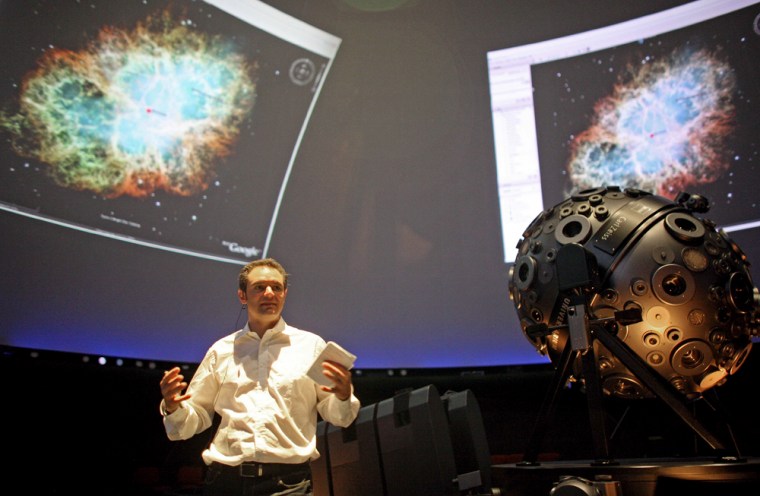Google Earth has launched a new feature called Sky, a “virtual telescope” that the company hopes will turn millions of Internet users into stargazers.
The upgraded version of the free software weaves together sky surveys conducted by the Palomar Observatory and the Anglo-Australian Observatory, along with images from the Hubble Space Telescope, to produce a zoomable view of the cosmos — in parallel to the zoomable satellite views of Earth offered by previous versions.
In effect, users can now zoom in on Earth's surface to the street level, or turn around and look skyward, zooming in on more than 100 million individual stars and 200 million galaxies.
“Never before has a roadmap of the entire sky been made so readily available,” Carol Christian of the Baltimore-based Space Telescope Science Institute, a co-leader of the institute’s Sky team. “Sky in Google Earth will foster and initiate new understanding of the universe by bringing it to everyone’s home computer.”
The software features different layers that show the life of a star, the layout of the constellations, high-resolution Hubble images and a user’s guide to galaxies. A backyard astronomy layer lets users click through stars, galaxies and nebulae visible to the eye, binoculars and small telescopes.
“And you don't have to know anything about astronomy to use the program,” Christian said in the institute's announcement about Sky.
Such planetarium programs have been available for years as standalone software, and there are also free Web-based planetariums such as WikiSky. But Google said incorporating the planetarium-style features into its Google Earth software could substantially expand interest in virtual as well as real-life stargazing.
Google Earth launched in June 2005, combining satellite imagery, maps and 3-D capabilities to display geographical information. The search-engine company says more 250 million people have downloaded the software since then.
Sky was incorporated into the latest version of Google Earth and made available for download Wednesday.
“We’re excited to provide users with rich astronomical imagery and enhanced content that enables them to both learn about what they’re seeing and tell their own stories,” Google product manager Lior Ron in a statement. “By working with some of the industry’s leading experts, we’ve been able to transform Google Earth into a virtual telescope.”
The imagery was stitched together from numerous sources, including the Sloan Digital Sky Survey, the Digital Sky Survey Consortium and the United Kingdom Astronomy Technology Center as well as the Anglo-Australian Observatory and the Space Telescope Science Institute. The imagery will be updated over time, Google said.
Google Sky blends the imagery from multiple sources seamlessly, said Andrew Connolly, an associate professor of astronomy at the University of Washington who participates in Google’s visiting faculty program.
“What’s unique about this is you have all of the imaging data over the whole of the sky actually streaming. So I can look at something that covers most of the sky, say our Milky Way galaxy, and I can zoom right into a tiny galaxy that’s in the formation cycle,” he said.
This report includes information from Reuters, The Associated Press and MSNBC.com.
